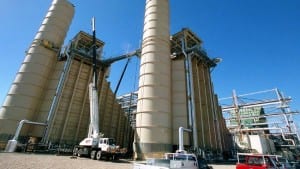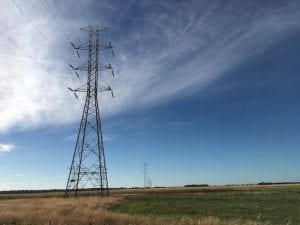The poles and wires sector is as big as the electricity generation sector, and it costs consumers just as much to have the electricity transported as it does to generate and sell. But poles and wires are relatively dull, compared to the excitement around wind and solar, and the sector has evolved more slowly.
Now, we believe, that is about to change, although it’s going to be hard work due to Australia’s 20th century regulatory model.
Customers are using the electricity network less than they used to, and consumption per customer is down about 20 per cent from 13 years ago. And household customers typically pay the network based on the quantity of electricity they consume.
But the networks have grown anyway, partly because the customer basis is also up around 20%, and partly because network revenue is mostly determined by the total value of the asset base.
Because there is less volume, but a growing revenue stream, the price charged by networks to customers for every KWh consumed increased sharply between 2006 and 2016, but has typically fallen in the past 3 years. Still, at around $80/MWh, it is about double what it used to be.
Regulators are incentivised to keep costs to consumers as low as possible and therefore they resist allowing any more capital expenditure than is absolutely necessary. And networks won’t spend on capex if they are not allowed to get a return on that investment.
Australia’s networks are dumb
The net result is that there is little investment in new technology and, as a result, the Australian networks are “dumb”. They can’t really see what’s happening to voltage and other things down at the street level.
This dumbness was reinforced by the different dumbness of the Australian Energy Market Commission, which sets the rules of the market, and which effectively took metering out of the hands of the networks, and gave the responsibility for metering over to the market and to consumers.
This means that the only group that knows much about household and street level consumption are the solar installers and the owners of household solar metering data.
Networks are likely to have a bigger role in how the grid works in the future. Distributed energy will likely need to do lots more in terms of frequency, voltage and power control.
However, for that process to happen properly they will need to be really incentivised. Almost inevitably this will mean that consumers will pay more before they pay less.
Frankly, the same thing is going to happen in generation as new capacity has to be built before the old is shut down, and that carries a cost. Perhaps I’m wrong.
A starting point may be community batteries, and for this we look at the detailed but complex KPMG study done for Ausgrid. As with many things we increasingly question whether it’s a good idea to just adapt the rules designed for one technology and market to the future technology, or whether it wouldn’t be better to throw out the old rules and start from scratch.
To renovate or knockdown? That should be a familiar issue to Australians.
The mostly unchanged nature of networks
The asset value of wires and poles is bigger than that of generation, yet the pace of change in networks has not kept up. So far networks, because they are regulated, have been able to mostly ignore many things that would be a big deal in another sector.
Specifically, over the past 14 years, total energy going through the networks, that is the volume measure, has been flat to declining and the amount of electricity consumed by the average household has declined by typically closer to 25% than 20%.
On the more positive side, customer nunbers are up by around 20% and maximum demand has also tended to rise. The regulated asset base [RAB] which drives electricity prices and returns to network owners has grown significantly.

For residential customers, and for the rooftop solar industry ,one important variable is what the consumers sees as the network component of the energy cost, expressed as $/MWh.
Broadly speaking, this is running at $80/MWh or higher and has broadly doubled since 2006. Importantly, though, it has declined for most customers since a peak in about 2016.
The decline is mostly due to falling interest rates, and to some extent due to lower costs in some networks.

Before getting on to adaptation to technology change, ie two way markets, community batteries, solar export limits and all the interesting stuff, it’s worth looking at the three main drivers of capital expenditure from a historic perspective.
They are: Population growth, every new housing development needs its substation and its wires and poles.
If ITK was running the system, that capital cost would be built into the price of the house. But now the connection effectively becomes a loan from the network company to the house and the house pays an annual fee, mostly depending on how much energy they consume, for ever and ever.
The “loan” can never be paid off. The fee is regulated.
The second source is “augmentation” and mostly that has meant increase substation capacity to deal with higher peak demand.
Consumers expect the lights to stay on even in bushfires and heatwaves and so the network has to be able to cope with the extreme peaks in demand even if they only occur for a couple of hours per year.
Mostly maximum demand is growing only very modestly, so there is not much need for substation capacity increases. The exception is Energex in QLD where demand has grown despite all the rooftop solar. The max demand number includes the non residential component.
The third form of capex is just replacement of old stuff. Wooden poles for instance or computer systems.
Regulation, incentives and stagnation
Networks get a more or less fixed amount of revenue each year as they are regulated via a “revenue cap”. This means that the regulator agrees once every five years a more or less fixed amount of revenue the network will receive per year from which it has to manage its capital and operating expenditure.
Both of the total energy and maximum demand are irrelevant to the amount of revenue. For regulatory purposes and within reason the network’s owners don’t care if no one uses the network.
Most of the revenue is an allowance for the rate of return on the capital base. If the network’s financiers estimate they have a lower cost of capital than the regulator allows then they are incentivised to get as much capital expenditure as possible into their allowance. And vice versa.
More broadly the networks only way to grow is by increasing capital expenditure.
As a result every new 5 year regulatory period the networks asks to increase capex over the period before and every since about 2014 the regulator knocks it back.
Networks are incentivised to cut costs, but equally they don’t want to tell the regulator they have cut costs because then the regulator will just build that in to the next review.
In short there is both a genuine incentive to be efficient and grow and equally an incentive to game the regulator.
Also one might infer from the data that electricity prices are high enough that consumers are incentivised to minimise consumption of electricity and to install solar.
It’s important to note that consumers are still mostly charged on the basis of how much electricity they consume, but networks are remunerated based on how much capital is invested and use of the network is explicitly not incentivised.
Some customers also have time of use as a cost driver, but that doesn’t matter much since the network is at far from full capacity these days.
The regulator in incentivised to keep costs to consumers to a minimum and to avoid damaging confrontation with either consumer advocates or network lobby groups. The network regulator has no incentive to be an agent of change.
Because of the revenue cap and because network thoughput (energy and demand) is either flat or declining the only way the regulator can keep control of prices is by limiting capital expenditure. So the regulator is basically incentivised to stop networks spending any money.
Ring fencing takes away the only avenue of growth networks had. I’ll talk more about this but assume for now that’s a correct statement.
This whole regulatory model is a recipe for technology stagnation and for the system to go backwards over time rather than forward
How technology might change things
As a result of focus on minimum cost and aided by a historically equally backward looking AEMC, networks are pretty dumb from a technology point of view.
Outside of Victoria only about 12% of residential customers have “smart” meters. And the smart meters that are installed are not very smart.
We can talk about meter functionality at length but initially a smart meter can communicate with “head office”.
That’s more than the original definition of smart, which just meant being able to record when electricity was consumed as well as how much.
The number of smart meters is increasing about 400,000 per year as a result of solar installations, new residential development installations and a natural replacement cycle for old meter (life about 25 years).
The back side of meters is how well prepared the network companies are to analyse the data from smart meters.
In general, thanks to the AEMC’s well intentioned but ultimately dumb and dumber “Power of choice” rules, we anticipate that both networks and retailers have gone about “smart meter” technology in a half hearted way.
Because of the lack of metering data, and because of the lack of investment by networks in “communicate and control technology” below the “SCADA” level, that is zonal substations, networks are blind to what is happening at street level.
A street level substation sits right at the top of my driveway. It’s not a thing of beauty. At least not to me. Does it really look a 21st century piece of kit?
I do wonder what a modern power electronics version would look like. A power electronics version would have a solid state transformer, which is way smaller, and can do two way power flow.
Other solid state components could include circuit brakers and filters. And then there is the prospect of a grid forming inverter to run a resilient microgrid.
Stepping into both the gap left by the blindness of the street level network to the system, and the lack of communicating meters, and the lack of devices that can control “back flow” voltage or report on and control frequency, stepping into all those gaps is the control system around rooftop solar.
Australia has a high rate of rooftop penetration, about 2.5 m buildings have solar growing at say 0.3 m per year.

Regarding batteries, there is no definitive data, but Sunwiz is likely closer to the market than most, and suggests there were about 70,000 cumulative installations, growing about 20,000 per year. Perhaps 8% of solar installs have a battery.
It’s the solar industry selling data to networks now
In the end because the networks are not incentivized to modernize grid technology, the end result is that the solar industry can give/use/sell its collective data back to the networks to advise about what actually is happening at street level.
This enables networks to things like “tap down” transformer voltage at street level substations.
But this is a hopeless situation looking forward.
What is the networks’ job as central generation falls away?
It’s quite clear that all the big coal generators are going away. In NSW, most will be gone in about 12 years time.
For this discussion the issue is that this will require a change in control. A new way to manage frequency, voltage and power and the 70% of so of inertia they supply is required.
One way to achieve this control might be to decentralise and democratize it. Either the right market, or a long second best choice, of a regulated provision of “system services” could result in a far more resilient grid, one that is highly resistant both to increasingly common weather related disruptions, and to cyber warfare, and one that enables peer to peer energy sharing, and lowers total costs.
Such a network might require much less new centralized generation and more of the customer dollar could be capture by networks as the “glue” in the distributed energy future.
But this will require the networks to be a lot bolder than they so far have been.
Community batteries
Judging by events in Western Australia, community batteries are an easy sell. However, in the NEM (Australia’s main grid centred on the eastern states) progress has been much slower.
KPMG conducted a feasibility study for Ausgrid dated February, 2020. The study authors aimed to answer the following question:
“Could a community battery initiative be feasible now or in the future”. The study considered technical issues, revenue issues and regulatory issues.
The first thing that surprised me in the study was that the installed cost of a community battery on a per KWh basis was no better than for a residential battery.
Considering that only one installation is required as opposed to say 100, and that batteries typically show economy of scale both with respect to power and duration, I’d expected better.
A 400KW/500kWh battery had an installed cost of $475,000, which is broadly $1,000/kWh. It was stated in the study that a bulk buy could save up to 15% off the cost. The installed cost of a 14kWh Powerwall 2 is about $14,000, although Origin offers it at $15,000.
It’s true that on a maximum power basis the Community battery is much cheaper, but from a household’s perspective the 5kW of a Powerwall 2 would cover anything short of say a house with two electric heaters running in addition to other devices.

Users are clear winner on capital costs
The KPMG study proposed to charge users $40/kWh/Year. This was an arbitrary number but it produces a 10 year cost about half that of a Powerwall and of course with more flexibility to adjust up or down.

If the Powerwall was going to last forever we would just have used the interest cost on $14,000 @ 5% = $700 per year, but it’s a wasting asset so it’s appropriate to use the full capital cost and write it off. So the user is a big winner compared to buying their own battery.
But what are the benefits to Ausgrid?
KPMG’s NPV (net present value) model, to the extent they presented the numbers, is shown in the figure below. It’s pretty obvious that if you fiddled with the arbitrage revenue you’d get a different answer

For the network revenue, KPMG saw this as transformer upgrade avoided costs (substation augmentation) and these were estimated at $50,000 to $250,000.
The study notes that the NPV of the recommended battery is higher than just a transformer upgrade because of the revenue the battery generates.
Even so, the concept of network micro grids/street level resiliency didn’t rate a mention.
Avoided loss of service penalty are a further revenue source
ITK notes that IPART (the NSW regulator) now proposes that if a user loses power for 40 hours a year, the user gets refunded the network portion of the bill, and for 15 hours blackout, they avoid about half the network portion of the annual bill.
So from Ausgrid’s perspective this would need to be probability weighted and then factored into the analysis.
The broader point is that the KPMG study didn’t go nearly far enough in this direction.
The third role of the community battery is to earn arbitrage and FCAS revenue, the same as any of the big batteries on the grid are supposed to do.
The study was quite positive on arbitrage revenue, however, it’s clearly highly uncertain.
The study didn’t assume much FCAS revenue. Most analysts assume that FACAS prices, particularly the “raise contingency” will fall as more batteries are installed.
However, one should also bear in mind the opportunity for more frequency events as inertia reduces and the broader control opportunity that will surely have revenue attached to it somehow. It’s a stretch today but it’s real.
Finally, the regulatory issues and solution
KPMG recommended a separate battery operator to deal with regulatory issues, and even so some ring fencing guidelines need to be amended.
Some rules that would need to change are:
- When the customer uses the battery they have to pay the full network charge;
- If half the customers use batteries and the other half do not, and tarffis are levied on the basis of “net”usage of the system then the half that don’t use the battery will pay much higher costs;
- Issues with the battery participating in the spot market include whether AEMO must dispatch it and ring fencing issues.
A separate battery provider with its own special network charge is a kind of halfway house. The Battery Provider can be owned by Ausgrid but is ring fenced from it. Profits made are retuned to customers.
In the end is there much in it for the network owner?
Ausgrid as an example
Ausgrid’s 1.7 million customers consume 25TWh of electricity a year or about 12% of the NEM wide total.
The customer base like that of Energex in QLD consists of residential, small business and big business so it’s a reasonably representative of all but very large industrials.
However, the public notion of gold plating is probably more due to the growth of Ausgrid’s regulated asset base when in Goverment ownership than to any other single factor.
Under private ownership since 2016 customers are doing better as can be seen in Figure 2 above.
However, it’s not really the owner that’s driven the improvement, although certainly Energex has not improved as much as the other networks.
The higher asset base means that customers may more for electricity but it is also true that the higher asset base meant a higher price when the network was sold, so consumers got some of those higher prices back in the form of a better state budget.
When the networks was still in Govt hands the higher asset value was, from one point of view, a tax, as the higher electricity prices lead to higher dividends to the State, but lets not get into that tortured debate.
If we assume consistency of the asset, that is that Ausgrid today is basically the same as Ausgrid of 2006 (when it was the wires and poles component of EnergyAustralia) then the following comparison from RIN spreadsheets on the Australian Energy Regulator website are a good comparison.

Since 2014 the decline has been arrested, at least in terms of demand but there is no growth.












